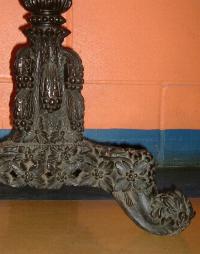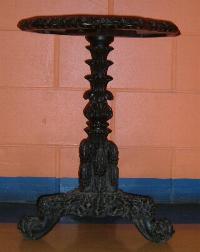ANTIQUES
FOR SALE


ANGLO-INDIAN
SIDE TABLE
Very
fine Anglo-Indian (possibly Burmese) tripod occasional table
in Indian hardwood, finely carved with beautiful flowers,
fruits and plants.
Height
0.680, Diameter 0.540
Price
£950.00 (AF1)
A review
on Furniture from British India and Ceylon
Christopher Ondaatje - Courtesy: The Sri Lankan Anchorman
15-08-2006
Growing up on a tea plantation in Old Ceylon, even as late
as the middle of the 20th century, I remember that virtually
all our western-style furniture was hand-made by local craftsmen.
It was simply more practical to commission it from them rather
than to buy it from the shops in the capital Colombo. As the
British realised immediately when they took over Ceylon at
the beginning of the 19th century, "Cinglese are ingenious
and expert artificers and display particular dexterity in
gold, silver and carpenters' work".
The fascination of "Anglo-Indian" furniture -that
is furniture made in colonial India for both British and Indian
use -lies in its peculiar hybrid nature. The chairs and tables
of the colonial period provide a carved, decorated and inlaid
guide to the conference of two very distinct cultures. Ironically,
precisely because of the subject's indeterminate position,
very little has been written about it: western in structure
and use, the objects have been overlooked by scholars of Indian
art; Indian in execution, they have been largely ignored by
western art historians. Amin Jaffer's new book sets out to
repair this omission. It is both a catalogue with detailed
commentaries on the Anglo-Indian collections (including a
brief but interesting section on Ceylon) in the Victoria and
Albert Museum in London and in the Peabody Essex Museum in
Salem, Massachusetts, and an introduction to the history of
colonial furniture with a substantial analysis of the contextual
issues arising.
Jaffer begins from a point that, once understood, seems obvious,
although it would not necessarily occur to one immediately.
He observes: "Furniture in the western sense did not
traditionally exist in Indian interiors, in which people ate,
read and socialised cross-legged on the ground. The Portuguese,
and later the Dutch, British and French, filled this need
in various ways, but above all by commissioning western-style
furniture from native carpenters." It is the sophisticated
commissioned pieces, made from precious materials in specialist
areas of craftmanship, that are so appealing to collectors
today because they combine a familiar form with exotic materials
and decoration.
For the lay reader, the strength of the book is its willingness
to engage in such social history as well as the scholarly
rigours of cataloguing the two finest collections of Anglo-Indian
furniture in the world. This imbues the catalogue with interest
beyond the aesthetic appreciation of the items. Jaffer's four
essays deal in turn with "Life in early British India",
"Furnishings in the domestic interior", "The
availability and acquisition of furniture" and "The
Indian consumption of western furniture and decorative articles".
Even by simply listing the essay titles, it becomes apparent
that the book's history of furniture in the 18th and early
19th century provides a history of the relations between the
two cultures. Jaffer draws our attention to the hybrid nature
of Anglo-Indian furniture early on, and his essays are as
much an investigation of that uneasily hyphenated epithet
as they are of the furniture itself.
He notes a Mrs Kindersley's remarks on the difficulties of
acquiring furniture in Calcutta in the 1760s: "Furniture
is exorbitantly dear and so difficult to procure, that one
seldom sees a room where all the chairs and couches are of
one sort; people of the first consequence are forced to pick
them up as they can, either from the captains of European
ships, or from China, or having some made by blundering carpenters
of the country, or send for them to Bombay, where they are
generally received about three years after they are bespoke."
Jaffer also introduces titbits of domestic information about
the obstacles to comfortable living for the westerner in India;
bedposts, for instance, were routinely placed in bowls of
water to prevent the devouring ants from destroying them.
All this helps the reader to visualise the furniture in use,
in actual interiors, rather than as part of museum displays.
Blundering or not, local artisans were renowned from the
start among the British for their remarkable skill as mimics.
Inevitably unfamiliar with western styles, and with no common
point of cultural reference, Indian carpenters produced items
that almost exactly resembled the external appearance of their
western counterparts while paying little attention to the
pieces' structure or function. But as the British settlement
flourished, Indian craftsmen developed a better sense of their
employers' taste, and by the 19th century they were rivalling
European standards of craftsmanship.
Of course, furniture was imported too, and the flow increased
during the 19th century as the desirability of all things
European became pre-eminent and Indian goods and customs -such
as the use of a hookah, watching nautches (Indian dances)
and travelling by palanquin, which had once been the height
of fashion -were disdained. Sadly, as Jaffer says: "The
stigma accorded non-European goods in the colonial market-place
echoed the overall policy of discrimination, and this increased
as the century progressed."
Thanks to the high mortality rate and the impermanent nature
of settlement, colonial India had a thriving second-hand trade.
Many articles could tell a tale of the many owners whose hands
they had passed through. Towards the end of the 19th century,
Edward Braddon noticed: "Every Anglo-Indian habitation
assumes in some degree the character of a second-hand furniture
warehouse or curiosity shop. There is a history attached to
nearly every piece of property... chairs, tables, whatnot
etc, all are souvenirs of people who have come and gone."
In his final essay, Jaffer looks from the opposite angle
at the British-Indian furniture phenomenon, and considers
the Indian consumption of western style. European goods had
an impact on Indian courts as early as the late 16th century,
but this was largely for their novelty value. Mirrors were
highly prized, being more effective than existing polished-metal
mirrors, and many Indian courts cultivated an appreciation
of European art. Lighting ideas were adopted too, and clocks
were often presented to Indian rulers. Jaffer observes that
such time-pieces were "entirely useless to a people who
divided the day into sixty units of roughly twenty-four minutes",
but they were admired for their chimes and appreciated as
much as curiosities as for any purpose.
Chairs, having no practical use in the Indian interior, where
life was conducted at floor level, developed into status symbols.
Originally, Indians kept them out of courtesy to Europeans,
but it became obvious that "a foreigner seated on a chair
above Indians of equal or higher rank seated on the floor
created an understandably uneasy situation with pecking order
flouted by the use of an object whose significance as a status
indicator crossed cultural boundaries". Some rajas tackled
the problem by seating themselves on thrones, which could
be occupied either in the western manner or with one's feet
tucked under, and which were one or two feet higher than any
other chair. Jaffer explores the symbolic decoration and embellishment
of these often-exquisite thrones.
The organisation of Jaffer's essays invites the reader to
make a comparison between the British and the Indian management
of the influence upon themselves of the other culture. It
is a comparison that favours the Indians. As against a predominant
"West is best" attitude of superiority among the
British, the Indians successfully lived with the western items
they adopted without either abandoning or over-asserting their
own lifestyle through their furniture. As Jaffer points out:
"However eagerly Indians took on the trappings of a European
lifestyle, their actual westernisation was most often superficial...
sitting on a chair or eating off a table constituted an alternative
type of behaviour, engaged in as desired or needed in a defined
Europeanised atmosphere, and existing side by side with, not
replacing, traditional ways of sitting or eating."
The introductory essays are indispensable to the reader as
one peruses the catalogue, because they enable one to imagine
the life of the pieces: being commissioned, used, bought and
sold, intimately connected with the lives of the people who
sailed to India to make their fortunes. Jaffer divides the
objects by region, which reveals how much styles varied between
the different centres of craftsmanship. He highlights some
of the difficulties facing the cataloguer, such as the fact
that a piece may have been made in India but by skilled Europeans
from fashionable imported timber, which makes it difficult
to classify as definitively Anglo-Indian, while the presence
of Chinese craftsmen in colonial India making oriental objects
creates further problems of differentiation. However, Jaffer's
descriptions are as rich and detailed as anyone could wish.
The Victoria and Albert Museum's collection is unparalleled
in range, size and importance, although it is heavily weighted
towards ceremonial objects and furniture made for an elite
market. The Peabody Essex Museum's collection dovetails perfectly,
offering less valuable but equally culturally important items
such as reed stools (the ubiquitous morha) and planters' chairs
(with elongated arms for resting the legs on), while also
filling some of the gaps in the V & A's holdings. Thus
Jaffer's book complements these already complementary collections
perfectly, giving us not only intricate and immaculately researched
catalogue commentaries but also the necessary historical and
cultural background to Anglo-Indian furniture previously overlooked
by historians of both cultures. Christopher Ondaatje is a
trustee of The National Portrait Gallery, and the author of
Woolf in Ceylon
The Antiquarian Style
An antiquarian or antiquary is one concerned
with antiquities or things of the past. More narrowly, the
term is often used for those who studied history with special
attention to "antiques" i.e. ancient objects of
art or science as physical traces of the past. Antiquarianism
is usually considered to have emerged in the sixteenth century;
by the nineteenth century it had become transformed and bifurcated
into the academic disciplines of archaeology and philology.
The Society of Antiquaries of London was formed in the 18th
century to promote the study of antiquities. As early as 1572
a society had been founded by Bishop Matthew Parker, Sir Robert
Cotton, William Camden and others for the preservation of
national antiquities. This body existed till 1604, when it
fell under suspicion of being political in its aims, and was
abolished by King James I. Papers read at their meetings are
preserved in the Cottonian library and were printed by Thomas
Hearne in 1720 under the title A Collection of Curious Discourses,
a second edition appearing in 1771.
In 1707 a number of English antiquaries began to hold regular
meetings for the discussion of their hobby and in 1717 the
Society of Antiquaries was formally reconstituted, finally
receiving a charter from King George II in 1751. In 1780 King
George III granted the society apartments in Somerset House
in The Strand. The society was governed by a council of twenty
and a president who is ex officio a trustee of the British
Museum.
The Society of Antiquaries of Scotland was founded in 1780,
and had the management of a large national antiquarian museum
in Edinburgh. In Ireland a society was founded in 1849 called
the Kilkenny Archaeological Society, holding its meetings
at Kilkenny. In 1869 its name was changed to the Royal Historical
and Archaeological Association of Ireland, and in 1890 to
the Royal Society of Antiquaries of Ireland, its office being
transferred to Dublin. In France La Société
Nationale des Antiquaires de France was formed in 1814 by
the reconstruction of the Acadêmie Celtique, which had
existed since 1805. The American Antiquarian Society was founded
in 1812, with its headquarters at Worcester, MA. It had a
library of upwards of 100,000 volumes and its transactions
were been published bi-annually starting 1849. In Germany
the Gesamtverein der Deutschen Geschichtsund Altertumsvereine
was founded in 1852. La Société Royale des Antiquaires
du Nord at Copenhagen was among the best known of European
antiquarian societies.
|